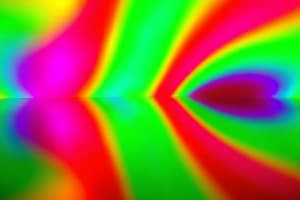Podcast
Questions and Answers
What is the phenomenon where light changes direction as it passes through a boundary between two media called?
What is the phenomenon where light changes direction as it passes through a boundary between two media called?
- Absorption
- Diffraction
- Refraction (correct)
- Reflection
How is the refractive index defined?
How is the refractive index defined?
- Ratio of light wavelength to speed in the medium
- Ratio of light frequency to speed in the medium
- Ratio of light intensity to speed in the medium
- Ratio of speed of light in a vacuum to speed in the medium (correct)
What property of a medium characterizes its ability to bend light?
What property of a medium characterizes its ability to bend light?
- Absorptivity
- Opacity
- Refractive index (correct)
- Reflectivity
If the refractive index of diamond is 2.42, which of the following statements is true?
If the refractive index of diamond is 2.42, which of the following statements is true?
In which medium would light bend more: a medium with a refractive index of 1.5 or a medium with a refractive index of 2.0?
In which medium would light bend more: a medium with a refractive index of 1.5 or a medium with a refractive index of 2.0?
What is the purpose of corrective lenses?
What is the purpose of corrective lenses?
What is the role of optical fibers in data communication?
What is the role of optical fibers in data communication?
How does Snell's Law relate to the behavior of light at boundaries between media?
How does Snell's Law relate to the behavior of light at boundaries between media?
What phenomenon involves total internal reflection in optics?
What phenomenon involves total internal reflection in optics?
What is the main application of prisms in optics?
What is the main application of prisms in optics?
Flashcards are hidden until you start studying
Study Notes
Light: A Fascinating Journey through Refraction
Light is an essential component of our world, powering everything from photosynthesis to virtual communication. As it travels, light interacts with matter, one of the most interesting interactions being refraction. This phenomenon, where light changes direction as it passes through a boundary between two media, offers insights into light's behavior and applications.
Refraction Basics
Refraction occurs when light enters a new medium with a different density or speed of light, altering its path. As it passes the boundary, the light is bent, or refracted, due to the contrast in the media's ability to transmit light, known as their refractive index.

Figure 1: Refraction of light as it passes from one medium to another. Notice the change in direction as the light enters the second medium.
The Refractive Index
The refractive index ((n)) is a dimensionless quantity used to characterize a medium's ability to bend light. It is defined as the ratio of the speed of light in a vacuum ((c)) to its speed ((v)) in the medium.
[n = \frac{c}{v}]
For instance, the refractive index of water is approximately 2.25, while that of air is 1.0. The greater the refractive index, the more severely the light is bent.
Refraction Applications
Refraction has numerous practical applications, such as:
- Corrective lenses: Contact lenses and glasses use refraction to change the direction of light rays entering the eye, correcting refractive errors like myopia, hyperopia, and astigmatism.
- Optical fibers: These thin strands of glass or plastic use refraction to guide light over long distances, providing high-speed data communication.
- Prisms: These devices use refraction to separate light into its constituent colors (spectrum), creating beautiful displays and facilitating scientific exploration.
The Snell's Law
One of the most well-known formulas in optics, Snell's Law, describes the relationship between the angles of incidence ((\theta_{i})) and refraction ((\theta_{r})) in two media with different refractive indices.
[\frac{\sin\theta_{i}}{\sin\theta_{r}} = \frac{n_{2}}{n_{1}}]
Snell's Law is useful in predicting how light will refract at a boundary between two media.
Total Internal Reflection and Applications
In some cases, when light passes from a medium of high refractive index to one of low refractive index, it can experience total internal reflection, where all of the light is reflected back into the first medium. This phenomenon is used in prisms to split light into its constituent colors and in optical fibers to keep light confined within the fiber.
Conclusion
Refraction is a fundamental property of light that has many practical applications and continues to shape the world around us. Whether we're wearing glasses to correct our vision, communicating data through optical fibers, or marveling at the beauty of a prism's color display, refraction continues to fascinate and inspire us.
Studying That Suits You
Use AI to generate personalized quizzes and flashcards to suit your learning preferences.




